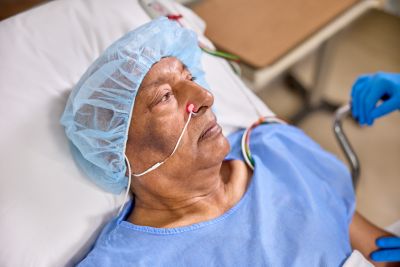
A promising innovation: non-invasive monitoring of arterial saturation
- By
- Featuring
- July 10 2025
- 4 min read
Dr. Aditya Hath Shukla, an intensivist in the Emergency and Intensive Care Units at Regency Hospital in Uttar Pradesh, India, shares his positive experience with using the Philips Nasal Alar Spo2 Sensor.
At-a-glance:
- Pulse oximetry, which measures peripheral arterial oxygen saturation, is a valuable tool for continuous, noninvasive assessment of oxygenation.
- Measuring blood oxygenation with continuous pulse oximetry can be difficult because it relies on the presence of an arterial pulse with sufficient volume.
- The Philips Nasal Alar SpO2 Sensor is an alternate site for monitoring of SpO2 in critically ill patients.
- This sensor can be valuable in the timely and effective management of patients with septic shock.

Continuous pulse oximetry is probably the most useful method for monitoring of blood oxygenation. It is non-invasive, gives easily understandable digital readings and requires minimal training. As such, it has become a standard of care for critically ill patients in the intensive care unit (ICU). The one limitation of this technique is that it relies on the presence of an arterial pulse of sufficient volume. Clinicians frequently have difficulty obtaining an accurate oximetry measurement in patients with decreased perfusion due to peripheral vascular disease, trauma to all four limbs, hypothermia or profound shock.
Septic shock is a severe, and often fatal, condition characterized by a significant drop in blood pressure, leading to insufficient blood flow to the organs. Monitoring and managing septic shock require precise and continuous tracking of a patient’s vital signs, including oxygen saturation (SpO2). The use of high doses of vasopressor drugs in these patients may affect peripheral circulation, making it difficult to obtain arterial pulses of adequate volume to ensure reliable and high-quality signals for the fingertip pulse oximeters. The values generated by fingertip probes may not be accurate in such scenarios. Moreover, they may place the patient at risk of needing more invasive forms of monitoring to guide treatment. Several alternative probe sites on the head have been suggested, such as the earlobe and forehead, for monitoring of SpO2 in critically ill patients. And recent technological advancements have resulted in the Philips Nasal Alar SpO2 Sensor – a pulse oximetry sensor specifically designed to detect SpO2 levels in the blood vessels of the nasal ala – as an alternate site for monitoring of arterial saturation in patients with shock.
Adopting the Philips Nasal Alar SpO2 Sensor for critically ill patients
In our practice, we have used the Philips Nasal Alar SpO2 Sensor as an alternate site for monitoring of SpO2 in critically ill patients, ever since it became available to us. The following are the observation and benefits I have experienced using it on hemodynamically unstable patients:
- The signals generated by the probe are better than that from fingertip pulse oximeter.
- The quality of plethysmography generated – even in patients on multiple vasoactive agents – was fairly good.
- SpO2 was consistently displayed.
These benefits may be due to the fact that the Alar SpO2 Sensor is placed on the fleshy part of the nostril, which has a rich blood supply and provides a stable and consistent signal. This is crucial for septic shock patients, who often experience poor peripheral perfusion due to vasoconstriction and hypotension, conditions that can impair the accuracy of fingertip sensors.
My early experience with the Alar SpO2 Sensors in managing septic shock patients resulted in more reliable and continuous oxygen saturation measurements.

Dr. Aditya Shukla
Improved patient comfort and compliance
Patient comfort and compliance are essential for effective monitoring, especially in critical care settings. The Philips Nasal Alar Sensors are small in size, less intrusive and more comfortable even for patients on non-invasive ventilation. How long it could be tolerated by patients without risking pressure injury needs to be ascertained in the long-term. Meanwhile, we have rotated the placement at two-hour intervals.
When it comes to septic shock patients and patients with delirium, reduced motion artifacts is a factor. One advantage of the Alar SpO2 Sensors over reflectance (forehead) probes is that the placement of Alar Sensor is less prone to motion artifacts, which can lead to loss of signal or affect the quality of signal in reflectance probes.
Philips Nasal Alar SpO2 Sensors are less susceptible to motion artifacts because they are placed on a relatively stable part of the body. This stability is particularly beneficial for septic shock patients, who may experience agitation or need frequent repositioning, ensuring that their SpO2 readings remain accurate and reliable.

Conclusion
My early experience with the Alar SpO2 Sensors in managing septic shock patients resulted in more reliable and continuous oxygen saturation measurements. These sensors have provided one more site for non-invasive monitoring of arterial saturation with SpO2. They can be valuable in the timely and effective management of patients with septic shock. The long-term role of the Philips Nasal Alar SpO2 Sensor is yet to be determined, but it is promising and will most likely have a place for regular and routine use in the future.
Copy this URLto share this story with your professional network
Disclaimer
Results are specific to the institution where they were obtained and may not reflect the results achievable at other institutions. Results in other cases may vary.